Campus Housing: Evolving to Meet Student Needs
- By Shannon O'Connor
- 04/01/18
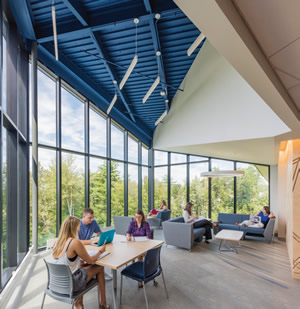
PHOTO © ANTON GRASSL
As we do each year, College Planning & Management recently surveyed college and university housing administrators to learn about the state of their facilities, what challenges they are facing, what the trends are in new facilities, and what improvements they would like to see in their residential life programs and accommodations. Here are some results and observations from that survey.
The design and furnishing of the “ideal” residence hall is a moving target. Evolving from 19th-century monastic-style dormitories with a dress code, a strict curfew, and designated meal times (and no women allowed), dorms developed into shared rooms with a couple of bunk beds and a small desk for each roommate, perhaps a chair, and a shared bathroom for everyone on the floor (men’s floor or women’s floor) at the end of the corridor.
Dormitories, initially designed to be not much more than a basic place to sleep and study, have taken on additional responsibilities on today’s campus. Modern residence halls provide not only beds, but also learning spaces, social and lounge spaces, recreation facilities, dining and cooking spaces, entertainment venues, medical/counselling offices, and more. A residence hall that presents itself as providing what students want is a valuable marketing tool for recruiting and retaining students for a college or university.
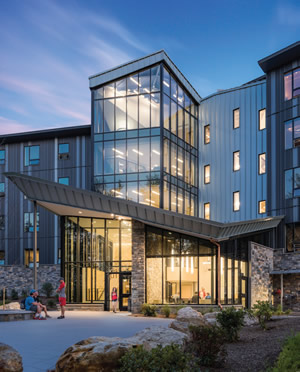
PHOTO © ANTON GRASSL
What is it, then, that today’s students want—or more likely, expect—in a residence hall?
According to a majority of CP&M survey respondents, the quest is for 21st-century amenities at an affordable cost… and privacy. At a time when the trend has been towards designing facilities for collaborative, shared learning and spontaneous socialization, more students are craving privacy. “More individual space,” “private rooms,” “single rooms,” and “private bathrooms,” are mentioned a number of times by our 2018 survey respondents.
Jordan Gatewood, AIA, LEED-BD+C, senior associate for Mackey Mitchell Architects in St. Louis, confirms this trend in requests for more private space, as well as a concern for all-around health and wellness, for residential students.
“Most institutions we work with are experiencing an increased demand for singlebedroom accommodations due to more students with special medical needs. One project we have under construction currently incorporates in the unit mix a small number of single bedrooms designed for students with autism spectrum disorder,” he says.
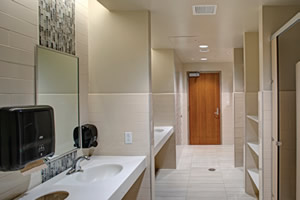
PHOTO © ALAIN JARAMILLO
“Bedroom and bathroom arrangements that provide both community and privacy are ideal for lower division students. Designing for flexibility in room assignments is increasingly important in context of creating more inclusive residential communities. More privacy in shared bathrooms and provision of single-user bathroom facilities
can be strategies to accomplish the level of flexibility housing officers are often looking to achieve.”
Another vital component of today’s perfect residence hall? The fastest WiFi. Of course.
Gatewood agrees. “WiFi has become the norm for connectivity, and many institutions are phasing out cable TV due to the predominance of online streaming.”
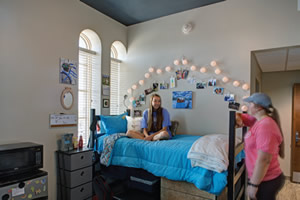
PHOTO © ALAIN JARAMILLO
The Survey Says
When we asked campus housing directors and administrators what expectations students have for housing, the dissonance between the list of students’ desired amenities and what housing directors are currently able to provide or are focused on providing—a sufficient number of beds, roofs that don’t leak, mechanical system upgrades (HVAC, lighting, etc.), remodeled bathrooms, functional furnishings, life-safety additions/upgrades, etc.—was substantial. Housing programs that are walking a narrow line between keeping their current building stock functional, comfortable, and safe and student expectations for something akin to the good life at a luxury resort on campus are probably not ready to offer high-end amenities. That doesn’t mean students won’t ask for the best.
With that observation made, what do our survey respondents have to say about the state of their campus housing stock, as well as the students living within it?
Space. Too Much? Too Little? Just Enough?
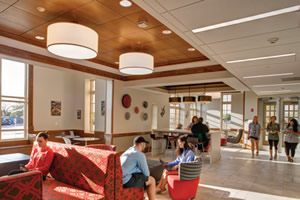
PHOTO © SAM FENTRESS
Depending on the sources you consult, the number of students enrolling in higher education is increasing, decreasing, or remaining about the same. According to the National Center for Education Statistics, undergraduate enrollment is projected to increase by 14 percent (from 17.0 million to 19.3 million students) between 2015 and 2026.
Online learning allows students—both traditional and nontraditional—to learn from where they live, with no need to travel to or reside on campus. Even so, campus housing remains a marketing tool for institutions looking to draw students to and keep them on campus. Schools need to offer sufficient beds and associated amenities. Too much real estate tied up in residence halls that are under-occupied is a drain on budgets and resources, but not having sufficient space for potential and current students might cause those students to instead enroll in an institution that can meet their desires as well as their needs. Are there sufficient beds available today?
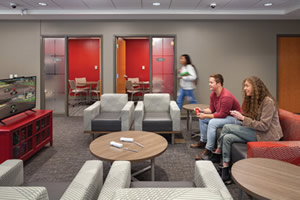
PHOTO © SAM FENTRESS
Answers to our 2017 survey of housing administrators showed that 60 percent of respondents felt they had sufficient space available; 32 percent indicated too little; and 8 percent indicated they have too much, resulting in unfilled beds. This year, the number of respondents indicating they have sufficient space dropped only slightly, to 59 percent; 32 percent indicated they have too little (the same as in 2017); and 9 percent say they have too much.
Down 12 percent from last year, 78 percent said they are not planning to add any new residence halls to campus in 2018-2019. A significant increase from 12 percent reported in 2017, 22 percent said they are planning to open new residence halls in 2018-2019. Of those 22 percent adding to their stock, over half of survey respondents, 54 percent, are doing so to increase the number of beds available. Thirty-five percent are replacing existing facilities. Forty-one percent intend for these new facilities to improve their school’s marketability/help with recruiting new students, while 31 percent are opening new facilities in order to keep current students living on campus.
Perhaps aligned with this goal of retention, in 2017, 13 percent responded that the new facilities underway were intended to create specialized living/learning communities (for first-generation students, or family housing space, to cluster students who are enrolled in similar programs together, etc.). For the 2018 respondents this goal almost doubled: 25 percent indicated that their new residence halls are creating specialized living/learning communities.
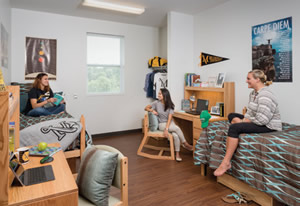
PHOTO COURTESY OF RISE: A REAL ESTATE COMPANY
Gatewood sees a striving for a balance between privacy and creating a sense of community, particularly in housing for lower-division students. “We do see a general decline of suite-style housing for freshman as it is usually a higher square footage/bed and has largely been found to not adequately support community building outside the suite. ‘Affordability’ and ‘value’ are two words we hear often as we look at the overall building program and determine sizes of individual spaces,” he explains.
This year, CP&M asked respondents who is developing, building, and funding new residence halls—in particular, if their institution had entered into a public-private partnership (P3) with a developer or other entity in order to build and/or maintain residential facilities on campus. Only 23 percent indicated they have done so; 77 percent have not. Gatewood is seeing P3 delivery making inroads into larger projects.
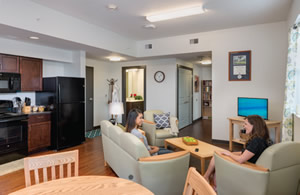
PHOTO COURTESY OF RISE: A REAL ESTATE COMPANY
“We are seeing an uptick in larger projects. Many large institutions are responding to increased demand or replacing aging facilities that very often were dense, high-capacity buildings. P3 delivery is becoming more common, especially for some of these large-capacity projects where there is either state mandate to use P3 or where the institution has the demand but not the debt capacity to build a substantial project,” he says.
Maintaining What’s in Place
Where new facilities are not underway, the looming specter of deferred maintenance, along with routine maintenance, renovations, and upgrades are keeping housing administrators busy. In 2017, only 44 percent of survey respondents indicated that they had renovations in progress, while 18 percent had renovations on hold due to budget constraints. Thirty-eight percent of respondents had no major renovations planned.
In 2018, the percentage who responded that they currently have renovations underway dropped to 25 percent. The number with projects on hold due to budget constraints also dropped, to 11 percent, while 42 percent have no major renovations/upgrades planned.
| TABLE 1 |
| General Maintenance |
90% |
| Mechanical/Electrical System |
66% |
| Technology/Networking Upgrades |
49% |
| Furniture and Fixtures |
75% |
| Carpeting and Flooring |
71% |
| Security and Life-Safety |
51% |
Table 1 indicates the types of renovations or upgrades that are underway or planned for the next three to five years. Down slightly from last year’s 96 percent, 90 percent of respondents indicate that general maintenance, painting, and repair are on the agenda. Seventy-one percent of respondents say carpeting and flooring replacements are necessary or in the works—no significant change from last year’s 70 percent—and 75 percent are planning or are undertaking furniture and fixtures replacement (last year it was 72 percent). The general consensus is that students are often hard on housing; keeping up appearances with general/routine maintenance of walls, floors, furniture, and fixtures is a vital minimum to keep residence hall spaces safe, functional, and appealing to new and returning occupants.
What’s in a Residence Hall? What Should Be?
From the perspective of our survey respondents it’s clear that students, and their parents, expect residential facilities to provide all the comforts and amenities of home… or better than home. With that said, there is no ideal, “one size fits all” cookie-cutter format for a residence hall. There are, however, common and/or popular amenities that are included or desired across the board.
| TABLE 2 |
| Do your current or planned residence hall spaces include... |
2017 |
2018 |
| Central kitchen |
44% |
35% |
| Central laundry facilities |
98% |
88% |
| Classroom spaces |
33% |
30% |
| Club-style fitness centers |
12% |
16% |
| Coffee shops |
16% |
16% |
| Dining hall |
35% |
33% |
| Faculty offices |
21% |
15% |
| Gender-neutral housing |
49% |
37% |
| Gender-neutral restrooms |
51% |
43% |
| Kitchen in rooms/suites |
47% |
45% |
| Maid services |
7% |
4% |
| Retail spaces |
14% |
16% |
| Swimming pools |
2% |
7% |
| Washer/dryer in rooms/suites |
16% |
12% |
In 2017, 98 percent of respondents indicated that their residence hall spaces included central laundry facilities. This year, that number dropped to 88 percent. In 2017, 44 percent indicated the existence of full-service central kitchens; this year that dropped to 35 percent. In the spirit of students wanting their own version of amenities, in 2017, survey respondents indicated that 47 percent of residence hall spaces do or will include kitchens in rooms or suites. In 2018, that number stayed relatively steady, at 45 percent.
Concerning kitchens, Gatewood reports that, “Community kitchens that are more visible and not tucked away are becoming commonplace in new hall design. These kitchens can offer new opportunities for Res Life programming, such as education around food preparation and diet or sharing native cuisine in the case of international students.”
In 2017, 35 percent of respondents indicated that their residential facilities included dining halls. This year, 33 percent responded in the affirmative; a negligible difference. With a drop, too, in the number of facilities reporting full-service central kitchens (from 44 percent last year to 35 percent this year) as well as a drop in the number reporting kitchen facilities in rooms/suites (47 percent in 2017, 45 percent this year), perhaps there is a trend to encourage students to leave their residential facilities to dine in other campus gathering places. Time will tell if this will become a trend.
Coffee shops within residence halls? In 2017, only 16 percent indicated they were or would be included. That number stayed the same this year.
Classroom spaces were indicated for 33 percent of facilities in 2016; that number remains fairly steady in 2018, at 30 percent.
Inspired by ongoing, sometimes acrimonious discussion, CP&M asked again this year if campus residence halls do or will include gender-neutral housing. In 2017, 49 percent indicated they do or will. In 2018, that number has dropped to 37 percent. Gender-neutral restrooms? In 2017 just over half, 51 percent, did. In 2018, that has dropped to 43 percent.
| TABLE 3 |
| Percentage of survey respondents who rated these issues as having the most profound impact on housing at their institutions in the next three to five years: |
| Aging facilities |
26% |
| Lack of adequate funds |
25% |
| Need for upgraded/modernized facilities |
24% |
| Deferred maintenance |
21% |
| Student/parent expectations |
21% |
| Cost to students |
16% |
| Keeping beds filled |
15% |
| Staying competitive with off-campus housing |
15% |
| Mental health issues |
13% |
| Civility/entitlement issues |
8% |
| Drug and alcohol abuse |
8% |
| Security concerns |
7% |
| Staffing issues |
6% |
| Overcrowding |
6% |
Looking Forward, What Are the Concerns?
The focus of housing directors remains firmly on the struggle to provide adequate safe, functional, up-to-date facilities for their residential students with limited budgets and resources.
When asked to rate the impact of a number of issues on housing at their institutions in the next three to five years, the five issues ranked as having the most profound impact were, in percentage order of concern: aging facilities, deferred maintenance, lack of adequate funds, need for upgraded/modernized facilities, and student/parent expectations… which is exactly the same as 2016’s and 2017’s top five. And again, as last year (except perhaps for student/parent expectations), the top four are directly related to financial considerations.
From the same question, the five items most often cited as not having any noticeable impact for the next three to five years are overcrowding, keeping beds filled, staffing issues, drug and alcohol use, and staying competitive with off-campus housing.
It Comes Down to the Students
Once the physical needs of shelter and safety are met—as close to student expectations as possible, knowing that the wish list will almost always exceed availability—we asked our survey respondents what is the one issue that concerns them most right now, and why.
“The cost of everything,” observes one respondent. “The college debt bubble is going to burst at some point, and we are part of that problem.”
“Pricing ourselves out of the market,” comments another. “Budget and staffing, because we could use more staff and funding to provide the services we intend to,” is another observation.
As might be expected, costs, funding, and condition of facilities top the list for 2018. Competition with off-campus facilities concerns some. A decline in enrollment, resulting in empty beds, is another. Another common concern that appears more frequently through the years of compiling these surveys is the students themselves.
“Student emotional fragility.” “Student behaviors.” “Mental health, and our ability to meet the needs of those students.” “Students who have mental illness or issues that we are not aware of.” “Sexual abuse, because it is rising on campuses.”
Facility design is accommodating this trend in concerns surrounding student health; mental, emotional, and physical, according to Gatewood.
“There is a growing interest and need for campus housing facilities to promote and support student wellness,” he says. “Institutions are all experiencing higher demand for mental and emotional health services. Stress-free zones such as yoga or prayer and meditation space, blackout shades and acoustics that support sleep, encouraging physical activity through placement of building elements and outdoor amenities, as well as satellite counselling offices are all ways we see wellness being incorporated into the programming and design of residential life facilities.”
Mentioned both by survey respondents and Gatewood is the increasing number of emotional support animals being brought into residential facilities.
“The increase of students with emotional support animals (ESAs) has many campuses thinking hard about their interior finishes and overall approach to accommodating ESAs,” Gatewood observes.
“ESAs can also impact other residents or even future residents who may have allergies, or an animal that is not being properly cared for properly by its owner can also be disruptive to other residents.”
Continuing to look at student experience and expectations, what is the biggest change housing experts have seen in their residence halls in the last five years?
An increasing demand and expectations for top-notch amenities remains the most frequently mentioned, leaving housing administrators scrambling to “keep up with the Joneses.”
“Incoming students are characterized by a deeper sense of entitlement and therefore have greater demands for amenities. This means FMs are trying to not only maintain existing buildings, but also enhance the features that are offered,” says one respondent. “[Students] want 21st-century amenities, crave privacy and unlimited Internet/WiFi bandwidth, expect pristine conditions at move-in, don’t want to take responsibility for damages which occur, and expect all this at a mid-1960s price structure which no longer exists,” says another.
Related concerns: “Staying competitive with off-campus housing.” “Demand for private living/low roommate ratios.” “Demand by the students for creature comforts.” “High expectations for amenities and at the same time, low cost.” “Our students don’t want to live in residence halls (even our state-of-the-art suite styles),” reports one respondent, “due to the enticing apartments we own right across the street.”
Campus housing directors are on the front lines, working out the balance between student/parent wants and needs; residents’ safety and security; budgets; regulations; what can be accomplished realistically and what cannot; and keeping existing facilities up and running, attractive, and functional. In the face of these ongoing challenges, they’re keeping an eye on the bigger picture. “We’re just trying to create a welcoming, engaging, safe community for our resident students,” explains one respondent.
CP&M would like to thank all who responded to our 2018 survey. The survey data was collected from 198 colleges and universities (163 four-year, 35 two-year; 115 public, 76 private/nonprofit, seven private/forprofit) representing 48 states, the District of Columbia, Puerto Rico, the U.S. Virgin Islands, Guam, and the Marianas Islands.
This article originally appeared in the College Planning & Management April 2018 issue of Spaces4Learning.